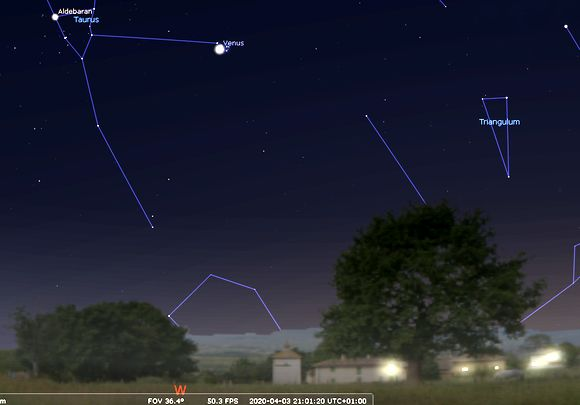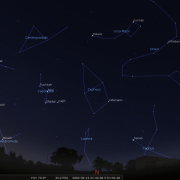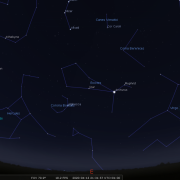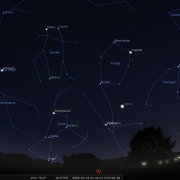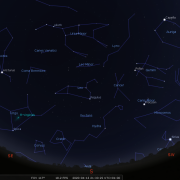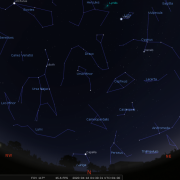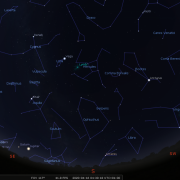Greetings to you all on this very strange April 1st. Please note changes to our diary. Unfortunately due to the current Corona Virus restrictions, all foreseeable events until June have been cancelled. The night sky, however, has not been cancelled: enjoy!
Welcome to the WDAS monthly newsletter for April 2020: a digest of the month's latest contributions to our website. Below you'll find Society News: including write-ups of the Dark Skies events at Fyling Hall School, Hunley Hall and Errington Primary School; a tour of the night sky in the form of Mark's "Baker's Dozen"; and naturally your Sky Notes for March.
Society News
Fylinghall School Star Event
Held on March 28th the ‘dark sky’ star gazing evening was, like last year, somewhat effected by external conditions – cloud. At least it wasn’t raining so some activities possible, and Mark was able to press gang some of the attendees to help demonstrate the scale solar system in the Stack yard.
To be honest this was a delaying tactic whilst Keith and the staff tried to figure out why the IT was not playing ball and was not allowing any projection onto the screen in the barn theatre. It ultimately turned out to be a broken core connection in their interconnect USB lead. Mark was eventually given the signal, allowing the indoor presentation to begin, and along similar lines to the ones at Danby. A question and answer session followed. Again, not the evening hoped for, but at least those attending seemed to enjoy their foray into the night sky from the comfort of a theatre. Perhaps third time lucky next year?
Hunley Hall Event
The following evening Mark drove over to Brotton and the Hunley Hall complex, to assist in some capacity with the dark sky event being run by the Hall management and members of Cleveland and Darlington A.S.
At the Hall Mark met up with John McCue, one of the key organisers, who many moons ago was instrumental in setting up NEGAS (the north east group of astronomical societies) with whom WDAS was also affiliated. The ‘Edinburgh excursion’ organised by NEGAS was worthy of been made into a comedy drama- but that’s another story!
John had been along to a WDAS meeting last year and had helped out at the Danby event, so it was nice to meet up again. Sadly, although some very early evening observations of the moon and Venus were possible, the weather rapidly deteriorated, with gale force winds and driving rain setting in. A shame as over 80 people had turned out, but at least the scheduled talks by Prof Carole Haswell of the Open University on Exoplanets proved interesting. Carole is actually a ‘local girl’, hailing from Saltburn, and was taught by John McCue at college. Shorter presentations on ‘light’ and the growing problem of ‘satellite’ pollution, followed by further activities to keep the youngerlings interested, fleshed out the evening. Yet another ‘let’s hope for better weather next year’ event.
Errington Primary School – Friday 13th
Having been contacted by Allan Fishpool, lower key stage 2 Leader at Errington Primary School, regarding a visit to coincide with the culmination of their science week activities, Keith and Mark journeyed over to Marske by the Sea, on Friday 13th March.
Locating the School relatively easily, (it actually turned out harder to gain access into the school, with a complete circumnavigation of it before this was achieved) we were finally let in by the caretaker who guided us along what seemed like a labyrinth of corridors to the main hall. This resembled a mini indoor festival, the floor strewn with tents and sleeping bags.
Following ‘meet and greets’ and touching of elbows, planned activities were outlined, before Keith and I journeyed out onto the playing field where we pointed out any visible stars in the night sky, to the first pupil groups. Conditions were not ideal, a little chilly, but clear patches of sky did keep appearing allowing winter constellations to be pointed out using the laser pointer. Pupil groups rotated from indoor activities to the outdoor camp fire talk, to our input and there were ‘several' rotations. By the final group however, conditions had deteriorated, cloud cover obscuring most of the sky. Returning indoors to the main hall via a quick ‘warm up’ by the camp fire, we utilised the interactive screen and web stellarium program to show the pupils the winter night sky. This was followed by questions and answers.
We were rather impressed by the good behaviour of the pupils and the level of questioning (it is not everyday a 9 year old asks about Hawking radiation!) I think they also learned a great deal about the night sky, and the teachers were most grateful of our input. After goodbye’s we exited the school, becoming lost just the once, a ball of string would have come in handy tied to the door we entered. Luckily the Minotaur was out of the building. Another partnership forged – though as matters now stand- it may be a while before we return.
Unfortunately due to current Corona virus restrictions the annual visit by pupils from Ayresome Primary School & Lego Innovation Studio has been postponed until later in the year.
Mark was contacted by Elizabeth Labelle; assistant Head Teacher (phase3) with the not too unexpected news, but hoped they would come to Whitby when restrictions are relaxed.
Due to the current restrictions associated with the Corona virus outbreak, (or those very likely to come into force) it is regrettable that all foreseeable events until June have been cancelled or postponed.
If the situation changes we shall let you know. We are all navigating unchartered skies.
For more information please contact:
Mark Dawson
33 Laburnum Grove
Whitby YO21 1HZ
Tel: +44 1947 605516
Sky Notes
In this month's Sky Notes:
Planetary Skylights
Evening Planets
Venus rules in the evening sky, whilst Mars, Jupiter and Saturn vie for attention in the dawn sky.

 Venus will continue to dominate the pre-midnight evening sky during April, a
Venus will continue to dominate the pre-midnight evening sky during April, a
brilliant beacon hard not to miss! At the start of the month Venus is involved in a spectacular conjunction with the lovely star cluster known as the Pleiades or Seven Sisters.
Observe over the first couple of evenings of April as Venus edges ever closer to the cluster, passing through the eastern fringes of the group on April 3rd. The view will be best appreciated through binoculars or a short focal length telescope at low power, which will also reveal the phase of Venus, which changes gradually to a crescent by the end of April.
Bear in mind that Venus is just a few tens of millions miles away, whereas the Pleiades members reside around 410 light years! If you have one, use a screw on colour filter (yellow or green) to reduce the glare from Venus and more comfortably distinguish the phase and perhaps even some subtle darker marking in the cloud duvet.
Venus reaches greatest brilliancy on April 28th – a brilliant - 4.7 in magnitude, bright enough to cast a shadow. A crescent Moon lies lower left of Venus on the 27th.


 Jupiter, Mars and Saturn are all located low in the east – southeast dawn sky. Of these, Jupiter is by far the most conspicuous to the eye, visible from 05:00h until dawn.
Jupiter, Mars and Saturn are all located low in the east – southeast dawn sky. Of these, Jupiter is by far the most conspicuous to the eye, visible from 05:00h until dawn.
To the left of Jupiter, resides pearly white Saturn, relatively prominent, but only a quarter the brilliance of Jupiter. Mars lies a little further to the east and is the least conspicuous of the three planets. The ‘Red planet’ has a distinct amber hue, but as yet is disappointing when viewed telescopically, the diminutive disk still too distant to reveal detail.
Even though far more distant than Mars, Jupiter and Saturn, the two largest planets in the solar system, have much to scrutinise in the eyepiece. Jupiter exhibits the cloud belts, great red spot and Galilean moons, whilst Saturn’s ring system is still orientated to us. A word of caution, the low altitude of these planets will make observations somewhat reliant on those moments of ‘good seeing’, so patience at the eyepiece is required. The waning Moon passes below Jupiter and Saturn on the 15th and Mars the following morning.
Meteors

This month’s most prolific meteor shower; the Lyrids, last from about April 16th until April 25th, peaking over the last hour of the 21st into the early morning hours of the 22nd this year.
The Lyrids are associated with comet Thatcher (C/186 G1) a periodic comet taking approximately 415 years to orbit the Sun. The comet last visited us in 1861.
Each April Earth plows through debris left behind by the comet giving rise to the shooting stars we observe. Lyrids are typically as bright as a second magnitude star, but as with most meteor showers there is always the chance of witnessing something a great deal brighter. These so called ‘Lyrid fireballs’ can exceed Venus in brilliance (which currently dominates the evening sky). Such shooting stars can momentarily cast a shadow, sometimes leaving behind smoking debris trails that can linger for over a minute.
Remember though that the vast majority of meteors are no bigger in size than instant coffee granules and even the really bright ones only marble sized!
The radiant of the shower lies not far from the lovely brilliant steely blue star Vega in Lyra - the Harp, which during the early morning hours is rising into the north east aspect. Observing at such a time, expect to spot 10-20 meteors per hour on the 22nd. Do not however look in the direction of Lyra, but instead view at least two hand spans away from it. The Moon is new on the 23rd – so prospects for the shower are very favourable.
A number of lesser meteor showers occur during April. The Virginids and alpha Scorpiids each have zenith hourly rates (ZHR) of half a dozen, or so, equating to ‘normal’ sporadic meteor activity levels. The Virginids peak over the night of April 7/8th, which coincide with the Full moon and will be drowned out. The Scorpiids peak on the 27th and will fare better but you will have to observe in the early morning hours.
|
Looking North
Mid-April - 21:30h |
Looking South |
|
Looking East
Mid-April - 21:30h |
Looking West
Mid-April - 21:30h |
|
Northern Aspect
Mid-April - 21:30h |
Southern Aspect
Mid-April - 21:30h |
|
Looking North (Early)
Mid-April - 04:30h |
Looking South (Early)
Mid-April - 04:30h |
Additional Image Credits:
- Planets and Comets where not otherwise mentioned: NASA
- Sky Charts: Stellarium Software
In-Focus
The start of April offers up an interesting stellar challenge, testing the observing dexterity of astronomers; casual or otherwise in a race against time.. This is all about spotting first magnitude stars; those ranked brightest in the sky.
Piercing the spring twilight dotted around the sky, no less than thirteen of these are currently visible, more than at any other time of year. However the window of opportunity in which to identify these stellar jewels rapidly diminishes as we head deeper into April, from little over an hour at the start, to just fifteen minutes by mid month. You will require clear views right around the horizon and complicating matters further, a number of planets may confuse the unwary.
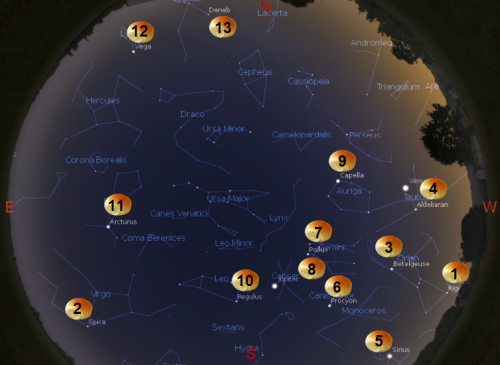
5-Minute Stellar Baker's Dozen Challenge of 1st Magnitude Stars (by Mark Dawson)
Click for full-size image with Key.
You will require clear views right around the horizon and complicating matters further, a number of bright planets may confuse the unwary.
Let us assume it is late March (post clock change i.e BST time) or early April, at which time twilight deepens around 9pm. Our first port of call lies over in the west, where the mighty hunter; Orion, is about to lose his right toe, marked by bright Rigel, (1) below the horizon. . A word of caution before we go any further. Two naked eye planets are to be found low in the west late March/early April - Mars and Mercury. Mars will have a distinct orange hue, Mercury may be harder to spot depending on what date you observe, so if the 'star' you are looking at doesn't seem to fit the constellation, well done, you have also spotted two planets.
Above Rigel, Orion’s three belt stars are aligned parallel to the west horizon, but the next star on our list, the conspicuous orange hue of Betelgeuse (3), is located above them. A hand span to the right of Betelgeuse and slightly closer to the horizon another orange star, Aldebaran (4) chief star in Taurus is visible in the ‘V’ of the Hyades cluster. Low in the WSW the brightest star in the sky – sparkling Sirius (5) should be quite unmistakable.
Having picked out this first clutch of stars, there is no time to waste, so raise your gaze somewhat higher, to pick out the next wave of luminaries.
Starting in the SW again seek out the bright solitary white hue of Procyon (6) in Canis Minor located above Sirius and to the left of Orion. Due west and higher still, Castor (7) and Pollux (8) denote the twins of Gemini, which is descending feet first down toward the horizon. At a similar altitude to Gemini further across in the WNW shines brilliant Capella (9) in Auriga, the only one of our bright seasonal winter stars not to set, being circumpolar from our latitude. Capella will spend the summer months arcing low above the north horizon and tricking the unwary into thinking it's the north star!
Turn and face due south, where midway up you will encounter bright Regulus (10) in the ‘sickle’ asterism of Leo. Our next two luminaries are located in the east. Due east, brilliant Arcturus (11) in the constellation of Bootes is very noticeable, its soft orange hue contrasting markedly with Sirius, the only star of the baker’s dozen brighter than it. Now for a test within a challenge, see how far into April you can spot both Sirius and Arcturus above the horizon at the same time! We still have three stars to locate, the first of which, Spica (2) chief star in Virgo, is just rising in the SE, so to spot it at the same time as the others a clear unobstructed view is required. Caution again- the very conspicuous 'star' above Spica is the planet Jupiter.
So, having viewed west, south and east, direct your gaze toward the North, where low in the North-East brilliant steely blue Vega (12) resides in the constellation of Lyra. Vega almost rivals Arcturus in apparent magnitude, but unlike the ‘guardian of the bear” it is circumpolar from Whitby’s latitude and to the unwary also masquerades as the north star during the winter months.
Our final star, Deneb (13) is located just above the NNE horizon and appears much less brilliant than Vega but is by far the most distant and massive of the stars visited. It too is circumpolar and along with Vega constitutes two of the three stars forming the ‘summer triangle’.
In less than three months, only Arcturus, Capella, Deneb and Vega will remain of our original stellar baker’s dozen, the rest having set. So, are you up for a fun observing challenge? Have a go! 
Events
 Observe the night sky with us at the Bruce Observatory, Whitby School
Observe the night sky with us at the Bruce Observatory, Whitby School
Observing Nights are held weather permitting: check for a relatively clear sky before leaving home. If in doubt, Mark can be reached on 07886069339
Please note the college drive gate is now operated via a electronic key code - so anyone wishing to attend must be at the car park at the top of the drive by 19:00hrs - unless an arrival time has been arranged with Mark/Keith.
 Observe the night sky with us at the Bruce Observatory, Whitby School
Observe the night sky with us at the Bruce Observatory, Whitby School
Observing Nights are held weather permitting: check for a relatively clear sky before leaving home. If in doubt, Mark can be reached on 07886069339
Please note the college drive gate is now operated via a electronic key code - so anyone wishing to attend must be at the car park at the top of the drive by 19:00hrs - unless an arrival time has been arranged with Mark/Keith.

